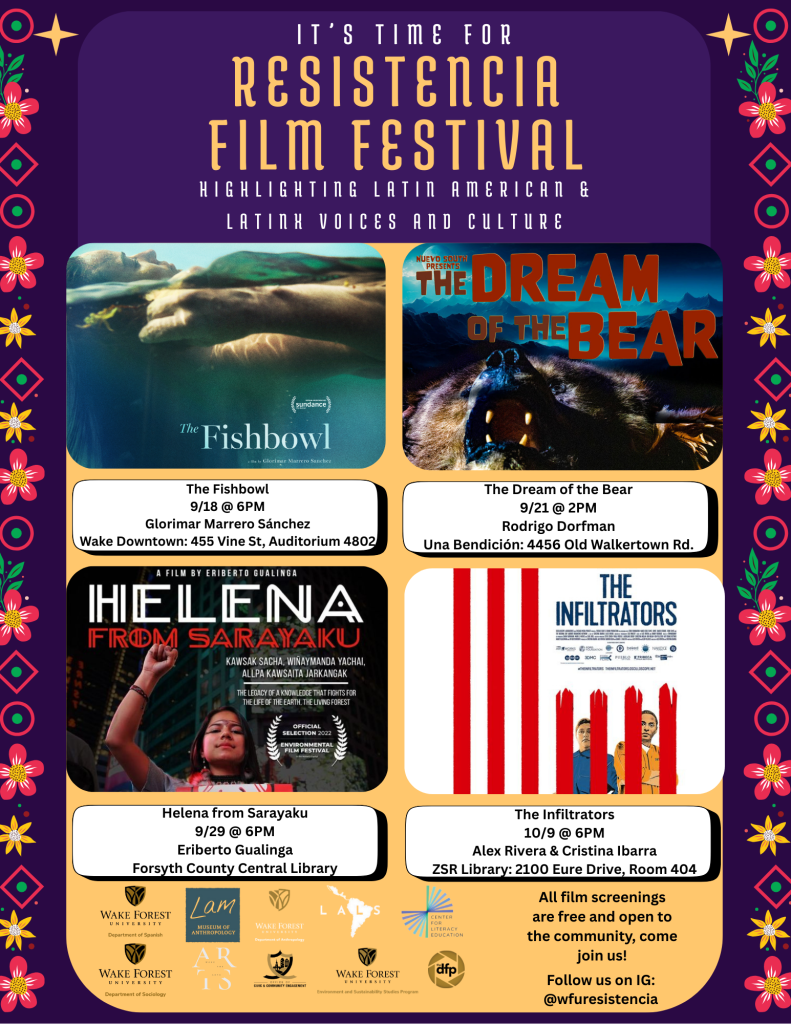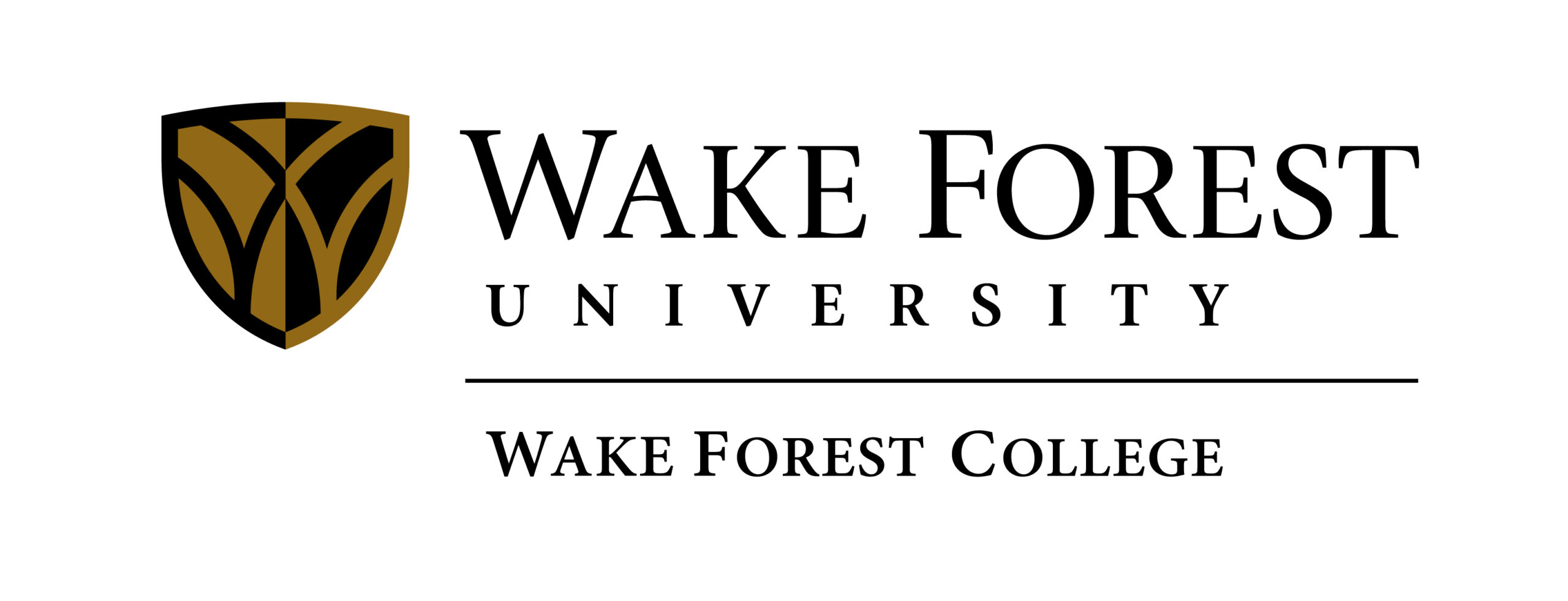Inside the Resistencia Film Festival: Q&A with Dr. Andrea Gómez Cervantes, Dr. Samanta Ordoñez Robles, and Professor Chris Zaluski
“The connection between film and community begins with careful choices: selecting the right films, considering the audience, and keeping in mind the needs and goals of the community. Cinema creates enjoyment from the simple act of sharing stories with others, generating experiences that can have meaningful benefits for mental health and for the well-being of the community at large.”
Dr. Andrea Gómez Cervantes, Assistant Professor, Sociology
Story by Erin Marlow, Communications Specialist in the Office of the Dean of the College; Video produced by Ryan Broussard, Graduate Assistant in the Office of the Dean of the College.
When Assistant Professor of Sociology Dr. Andrea Gómez Cervantes, Associate Professor of Spanish Dr. Samanta Ordoñez Robles, and interdisciplinary campus partners launched their faculty seminar, “Building Campus and Community Solidarity Through the Arts,” they envisioned campus outreach projects in Winston-Salem. That vision grew as the seminar became the fertile ground for something bigger: the Resistenca Film Festival, a community-wide, interdisciplinary festival that fosters cross-cultural understanding and a shared sense of strength and resilience in the face of oppression.
Together, Dr. Gómez Cervantes, Dr. Ordóñez Robles, and Associate Teaching Professor and Director of the Documentary Film Program Chris Zaluski brought the festival to life. Dr. Ordoñez Robles, with her expertise in teaching Latin American film and literature, curated the Resistenca Film Festival’s list of featured films: The Fishbowl, The Dream of the Bear, Helena from Sarayaku, and The Infiltrators, each centered on the complex sociopolitical issues, cultural histories, and lived realities of Latinx, Latin American, and Caribbean communities. Professor Zaluski guided the festival’s development and managed the technical aspects that enabled the screenings to take place.
Reflecting on the festival’s vision, Dr. Ordóñez Robles, Professor Zaluski, and Dr. Gómez Cervantes — who focused on the community engagement elements of the festival — spoke with the Dean’s Office about the festival’s collaborative approach and how cinema fosters meaningful community discussion.
How did you curate this particular lineup of films — The Fishbowl, The Dream of the Bear, Helena from Sarayaku, and The Infiltrators? What themes connect them?
Dr. Ordóñez Robles: The stories are of people and communities taking assertive steps toward healing, safety, and restoration in the face of state violence, extractivism, contamination, and colonial legacies of cultural genocide. Rather than portraying these individuals as helpless victims, the films emphasize both their agency and the community-oriented ways they resist and navigate challenges. The lineup opens up dialogues on some of the most pressing issues facing Latinx, Latin American, and Caribbean communities today, including environmental devastation and illness caused by neocolonial extractivism, unequal access to healthcare, the precarity of undocumented migrants, the destruction of ecosystems and collective lifeways, and the dehumanization of detention.
How do you hope showcasing these Latin American and Latinx films will resonate with both Latinx communities and broader audiences in Winston-Salem?
Dr. Gómez Cervantes: We see the act of showcasing Latin American and Latinx films, creators, and artists as a form of cultural resistance. At a time when the political rhetoric seeks to vilify, criminalize, and silence Latinx communities in the United States, creating fear both within these communities and toward them, the festival aims to shift the narrative.
For Latinx audiences, we hope the films affirm their identities, histories, and sources of joy. For broader audiences in Winston-Salem, we hope the festival sparks a deeper appreciation for the richness and diversity of Latin American cultures, invites reflection on shared struggles and aspirations, and highlights the many ways communities across the region create beauty, resilience, and joy.
Which of the films especially moved you during the selection process?
Dr. Ordóñez Robles: The Dream of the Bear is a work-in-progress, but the director, Rodrigo Dorfman, generously agreed to present a version and receive feedback from the audience. The story is especially powerful because it was co-created in North Carolina by an undocumented migrant with roots in an Indigenous community in Mexico. The protagonist narrates his own story and reflects on how embodied knowledge emerged through his participation in an Aztec dance group in Raleigh, which allowed him to experience a process of spiritual rebirth and self-discovery.
What makes this film so compelling is that it offers a deeply human perspective on migrants in our state. It presents them not simply as victims or as laboring bodies but as individuals with rich inner lives and spiritual practices. It also highlights the resilience of Latinx and Indigenous communities established in North Carolina, whose practices of communality and cultural resurgence serve as sources of collective strength.
[At the end of the showing,] the director held a dialogic feedback session in which the community itself could contribute to shaping the final version of the film.
What is the connection between film and community? How do you see film as community work?
Professor Zaluski: The connection between film and community begins with careful choices: selecting the right films, considering the audience, and keeping in mind the needs and goals of the community. Cinema creates enjoyment from the simple act of sharing stories with others, generating experiences that can have meaningful benefits for mental health and for the well-being of the community at large. Representation also matters: films can affirm identities, tell stories that might otherwise go unheard, and counter dominant narratives that marginalize particular groups.
Film also builds community through the collective experience of screenings. Whether in a theater, an outdoor space, a classroom, or online, shared experiences of moviegoing bring people together, generating dialogue, solidarity, and, at times, even activism. When a community watches films together, they are not only consuming a story; they are also engaging with it. They are negotiating shared meanings, memories, and emotions. In this way, film becomes more than just an artistic or cultural product; it is also a space for dialogue, political education, cultural preservation, and critical reflection.
What do you hope audiences will take away from attending these screenings, and how do you see the festival growing in future years?
Dr. Gómez Cervantes: We hope audiences will leave the screenings with a deeper understanding of the complex realities that shape Latinx, Latin American, and Caribbean communities, which are too often overlooked or simplified in mainstream media. The films invite viewers to recognize both the systemic forces that generate harm and the creative, communal forms of resistance that emerge in response. More than just learning about distant struggles, we want audiences to see how these issues resonate locally in Winston-Salem and within the WFU community.
Core to the university’s mission of Pro Humanitate, Wake Forest students have been directly engaged in one of the central goals of Resistencia: fostering solidarity and meaningful connection across communities. In partnership with two community organizations, students have worked alongside faculty and community leaders to design class assignments that translate themes from the films into real-world action. These assignments culminate in an “Act of Kindness,” where students work to identify a need, design a response, and implement it in collaboration with community partners. In this way, students are not only reflecting on issues of justice, migration, identity, and resilience highlighted in the films but also embodying the spirit of resistance by practicing care, advocacy, and creativity in tangible ways that benefit the local community.
In the future, we plan to involve community members more directly in the process of shaping the festival itself. By building stronger partnerships with local organizations and inviting more voices into the planning, we want the festival to generate deeper dialogue and have a more tangible impact both on campus and in the broader Winston-Salem community.
Learn more about The Resistencia Film Festival on the Latin American and Latino Studies Program website.



“ When a community watches films together, they are not only consuming a story; they are also engaging with it. They are negotiating shared meanings, memories, and emotions.”
Dr. Andrea Gómez Cervantes

